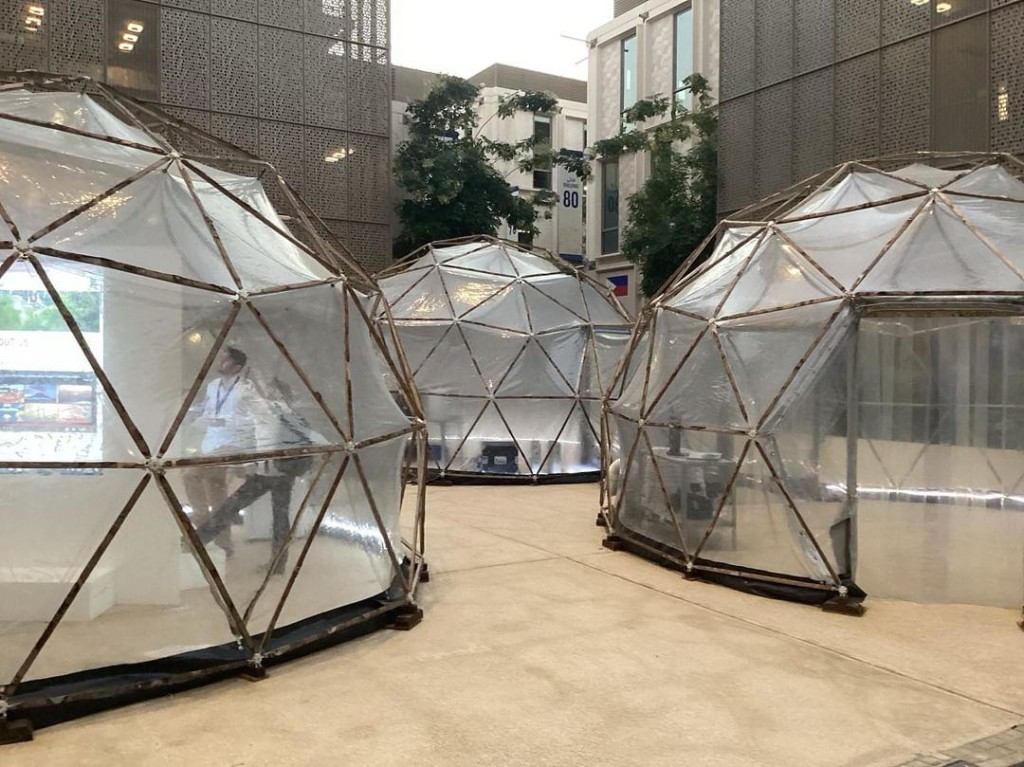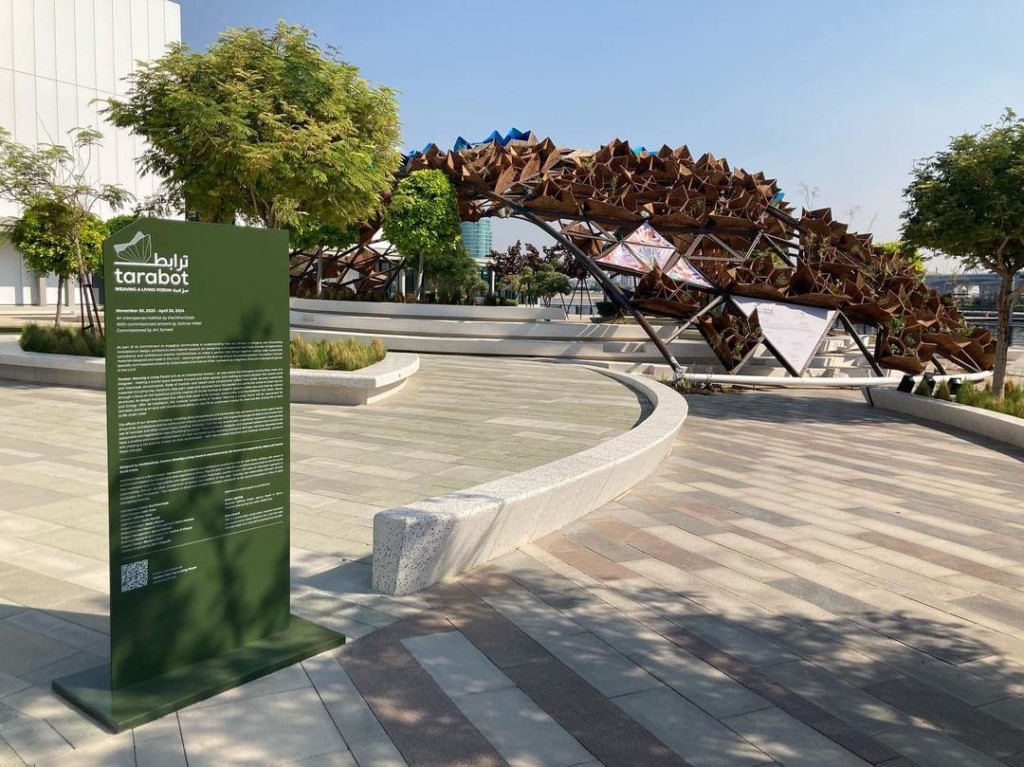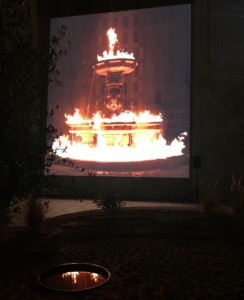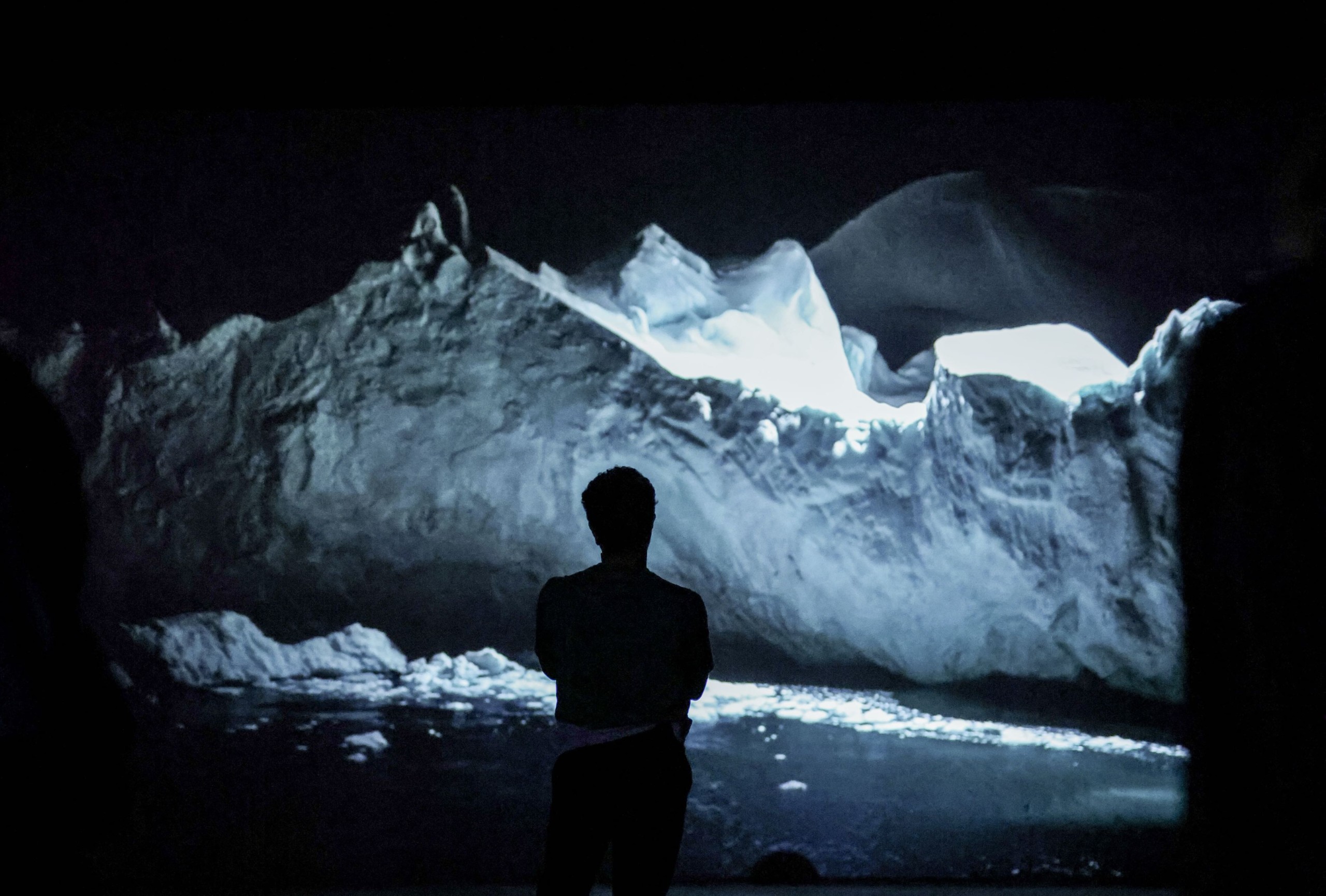On November 30, COP28 opened, the most important gathering in the world on climate change. The same day, Alserkal Avenue, one of Dubai’s principal art centres, unveiled “Melting Point”, an exhibition prepared for COP28 by Franco-Swiss artist Julian Charrière. Two monumental fountains ablaze occupied its exterior courtyard, whilst inside, visitors could sink into the depths of the planet’s iciest landscapes, the glaciers of the Arctic.
In the end, whilst the event’s final agreement remained unsatisfactory regarding the speed of abandonment of fossil fuels, it was a COP28 that can be said to have marked a tipping point for arts and culture. In addition to the increased sight of artistic exhibitions, there was a tangible sense of a growing collective power, generated in particular by the Climate Heritage Network’s ‘Global call to put cultural heritage, arts and creative sectors at the heart of climate action’.
From the heart of the official UN Blue Zone, passing through Dubai’s artistic venues, and as far as neighbouring Abu Dhabi, culture and climate action came together to provide hope, and solutions, for our planet’s future.

Opening of “Melting Point”, Alserkal Avenue. Right to left: Vilma Jurkurte, Abdelmonem Bin Eisa Alserkal, Julian Charrière, Alice Audouin. Photo: Alserkal Initiatives
In the belly of the dragon: art in the COP Blue Zone
COP28 – the 28th Edition of UN Framework Convention on Climate Change (UNFCCC) Conference – was held over two weeks at Expo City Dubai, a large state-of-the-art building complex conceived for the city’s hosting of the 2020 World Expo. At its heart is the ‘Blue Zone’, in which myriad national and thematic pavilions are found, as well as the key conference rooms attended by the head of states, ministers, experts and journalists.
Within this very un-artistic setting, the centre stage was taken by Refik Anadol, whose panoramic multi-coloured projection took over the central 130m-wide dome of the COP28 site as night fell. His digital artwork – named ‘Data Portal: Nature’ – integrated hundreds of images of water, coral, flora and paintings by the indigenous Brazilian Yawanama people. Its message was one of the fragility of our precious ecosystem and the urgent need for environmental preservation, citing Yawanawa Chief, Biraci Yawanawa: “It’s time for humanity to reconnect with our origins, with the Earth, with our hearts. It’s time to make alliances, to join forces.”
During the daytime, the bright Dubai sunshine unveiled a number of other art installations and initiatives spread across the Expo 2020 site. Complementing Refik Anadol’s inspiring and far-reaching message, a more concrete proposal was presented by Google Arts & Culture, who had commissioned artist Yiyun Kang to create an interactive experience around solutions that respond to the impact of climate change on the global water cycle. In collaboration with data from NASA, “A Passage of Water” let visitors discover two potential solutions to our freshwater crisis: seawater desalination and rainwater harvesting. “Art can serve as an exceptional vehicle for fostering a deeper understanding of pressing issues,” highlighted Kang in a recent interview.
Alarming data was also powerfully brought to life by the presence of Michael Pinsky’s Pollution Pods, that allowed passers-by to experience first-hand the unsanitary levels of air pollution in three of the world’s most populous cities, New Delhi, London and Beijing. Their presence here as well as at previous COPs – COP25 in Madrid and COP26 in Glasgow – only goes to show the art project’s perceived ongoing relevance, which also serves to bring awareness to two long-term initiatives: the Clean Air Fund and Breathe Cities.

Michael Pinsky, Pollution pods. Photo: Art of Change 21
Other artists present include Josefina Nelimarkka, whose artwork on the importance of clouds was displayed at the Finnish Pavilion, Selva Ozelli, with an online exhibition displayed at the Ocean Decade + OceanX Pavilion, as well as the artists invited by the UN to respond to their Sustainable Development goals (SDGs), including Charlotte Qin’s calligraphic interpretation of SDG 6: ‘Clean Water & Sanitation’.
Many artists this year made their presence felt not only through artworks but also via their participation in an unprecedented number of talks in the official programmes. Art of Change 21* and France Muséums invited UAE-based artist Talin Hazbar to speak as part of a co-organised panel at the French Pavilion, “The power of art in response to the climate crisis”. Elsewhere, the Nordic Pavilion’s round-table “No Transformation Without Imagination: The Power of Arts and Culture for Green Transition” also gave the stage to artist Jessie Kleemann, alongside scientists and sustainability experts.
The fire spreads: Local cultural players eager to participate
Unlike last year’s COP27, held in Sharm el-Sheikh in Egypt, Dubai benefits from a well-supported artistic ecosystem and numerous world-class arts institutions. Many of them took COP28 as an opportunity to promote relevant artists or to rethink their own environmental practices.
Central to Dubai’s contemporary art scene is Alserkal Avenue, home to many of the region’s leading contemporary art galleries, supported by a central programming by Alserkal Initiatives. On the occasion of COP28, the latter invited Art of Change 21* to curate a special exhibition by artist Julian Charrière, incorporating three of his most iconic and salient video works related to climate change. The exhibition “Melting Point” focuses on the dual beauty and precarity of glacial Arctic landscapes, which are retracting alarmingly with each passing year, threatening our planet’s equilibrium. Contrasting these glacial images is a video of his Promethean fountain of fire, “And Beneath It All Flows Liquid Fire”, that recalls the collision of magma and water at the earth’s surface, as well as the birth of the human civilisation, and its self-destruction at the hand of combustible fossil fuels. For Julian Charrière, “culture should have a strong voice at the COP, a voice that is not sufficiently represented”.
Nearby, still in Alserkal Avenue, these themes were amplified at Leila Heller Gallery, with Diane Tuft and Maxi Cohen’s photographic exhibitions respectively around the polar regions and the cultural importance of water. At neighbouring gallery Volte Art Projects, what first appears to be a giant mural seascape by artist Rashid Rana, is in fact, when seen up-close, a collation of thousands of images he has taken around waste dumps in Pakistan. This trompe-l’oeil, part of his solo exhibition “It lies beyond”, highlights various issues, including the damage created by colonisation, the Industrial Revolution, consumerism, human waste and pollution.
Across Dubai, at the Jameel Arts Center, the focus was on providing some solutions to this ecological devastation. Launched in time for COP28, its new outdoor architectural pavilion Tarabot, by Adib Dada, founder of regenerative consultancy and architecture practice theOtherDada, is a call for the creation and integration of new circular ecological support systems, itself made from modular components crafted from locally sourced, sustainable materials including clay, mycelium, date palm waste and upcycled fabric. After deinstallation, the installation will take on a new life as an underwater habitat for coral and fish, providing a symbolic connection between life on land and life underwater. Also at Jameel Arts Center, the “Artist’s garden” project currently features Zheng Bo, whose video work shows a collaborative dance between two human dancers and a Samur tree growing in the Mleiha desert in Sharjah, a sensual suggestion for how humans can rekindle our understanding and connection with the land.

Tarabot, Jameel Arts Center. Photo: Art of Change 21
No art trip to Dubai is now complete without a visit to neighbouring Abu Dhabi, whose institutions also sought to express their environmental engagement.
First of all, the NYU Abu Dhabi (NYUAD) Art Gallery, which hosts an outstanding solo exhibition of the long-time environmentally-engaged artist Blane de Saint-Croix. Entitled “Horizon”, highlights include “Salt Lake Excerpt”, a 150m2 sculptural installation inspired by the salt lakes (“sabkhas”) of the UAE, made from PET flakes recycled from more than 50,000 plastic water bottles.
The question of materials was also explored as part of a dedicated symposium at the Louvre Abu Dhabi on the issue of “sustainability in museums”. Co-organised with France Muséums on December 7th, the day welcomed, among others, Bruno Girveau, director of the Palais des beaux-arts de Lille, Amareswar Galla from the Kalinga Institute in India, Alice Audouin, founder of Art of Change 21*, Maya Allison, director of the NYUAD Art Gallery, and Andrew Potts, spokesman for the Culture Heritage Network. Discussions included how sustainability can guide curatorial choices (Alice Audouin) and how a museum’s existing collection, innovatively-curated, can provide enticing new material for shows (Bruno Girveau).
A first step towards integrating culture in climate action
This plethora of art events doesn’t diminish the fact that today arts and culture remains a minority voice at COP28, even at a time when many cultural sites are seriously threatened or already damaged by the effects of climate change: heat waves, rising water levels, desertification, storms, fires…
It is vital that these spaces dedicated to local cultures, histories and practices are preserved, because heritage – just like contemporary art, its modern representation – can provide meaningful solutions to today’s crisis. They also form the cultural fabric of our societies, essential for the necessary environmental policies to be successfully adopted by the individuals that make up our society.
Could COP28 mark the beginning of the end for this discord?
More than 1,500 signatories from the fields of art, culture, heritage, including indigenous and island voices, were united before COP28 towards the “Global call to place cultural heritage, the arts and creative industries at the heart of the climate action”, coordinated by the Climate Heritage Network (CHN) – and the tireless efforts of Andrew Potts. Among the founding members: UNESCO, ICOM, Julie’s Bicycle, Europa Nostra, the International Trusts Organization (INTO), the president of OHAI Tonga Uili Lousi, and Art of Change 21*.
This collective effort seems to be bearing fruit. At this COP28, culture achieved unprecedented representation at the political level, including the organisation of the first ‘High-level Ministerial Dialogue’ on culture-based climate action at the COP, co-chaired by the Ministers of Culture of Brazil and the UAE, and the launch on December 8 of the first ministerial “Group of Friends of Culture-Based Climate Action”. What comes next is just as ambitious: the latter will work alongside CHN members to secure an officially-recognised working group at COP29 next year in Baku, Azerbaijan. This in-turn would lead to a year-long consultation on culture and climate to arrive at the first UN Climate Change policy regarding the role of culture, at COP30 in Belém, Brazil, in 2025.
Whilst the flame of Julian Charriere’s fire fountain will soon be extinguished, upon the exhibition’s closing on January 6, three weeks after the end of COP28, it will be passed onto other artists across the world, those who continue to light up arts institutions and other public arenas in this time of climate emergency.
In parallel, we encourage all our readers to support the Call to Action and ensure that arts and culture can be recognised as an integral part of the solution to climate change at COP29 and COP30 – a role that this COP demonstrates it should have.

Julian Charrière, And Beneath It All Flows Liquid Fire, Video still, 2019. Courtesy the artist. Photo: Art of Change 21
Stefano Vendramin
December 2023
* Publisher of Impact Art News. For nine years, since COP21, Art of Change 21 has been bringing artworks to these significant annual conferences, amplifying the voices of artists and civil society and bringing to life the environmental emergency and issues we face. Find out more
Cover image: Exhibition view “Melting Point”, Alserkal Avenue, co-curated by Art of Change 21 & Alserkal Initiatives. Artwork: Julian Charrière – Towards No Earthly Pole, 2019, video. Courtesy the artist. Photo copyright: Alserkal Initiatives
Impact Art News, Nov-Dec 2023 #46
Subscribe to Impact Art News (free): here

